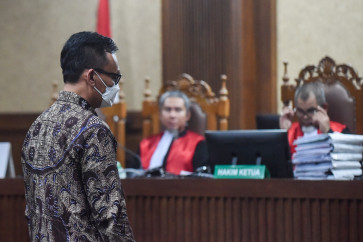Popular Reads
Top Results
Can't find what you're looking for?
View all search resultsPopular Reads
Top Results
Can't find what you're looking for?
View all search resultsGarment inspired by the stars boost business
TWICE A WEEK: Tasik market vendors operate independently under temporary tents in a vacant lot next to permanent stalls at Tanah Abang market
Change text size
Gift Premium Articles
to Anyone
TWICE A WEEK: Tasik market vendors operate independently under temporary tents in a vacant lot next to permanent stalls at Tanah Abang market. For years, these vendors have only had to pay "security" fees to local thugs to remain in operation. (JP/Triwik Kurniasari)
The woman sat in front of colorful headscarves scattered on the floor of her makeshift stall at the side of a narrow street near Tanah Abang market, Central Jakarta.
She offered her merchandise to people who passed her tent, trying to grab their attention with her loud voice.
A popular headscarf is the gelombang cinta (waves of love), which is named after a species of Anthurium plant that was very famous in the country a while ago. Another one is ayat-ayat cinta (verses of love), taken from a local flick. This type of headscarf became popular after actress Rianti Cartwright wore it in the blockbuster movie.
"Gelombang cinta, gelombang cinta... Mam, Sir. Please, come. It's only Rp 8,000 (less than US$1)," Iis, 45, said loudly.
Many people came to her stall. Some of them bought one or two pieces only, while others buy dozens to sell again.
"It's quite cheap. I don't take much profit from it. It is much cheaper if you buy a kodi (20 pieces). I sell a kodi of headscarves for only Rp 100,000," said Iis, who lives in Tasikmalaya, West Java.
The area where Iis runs her business is called Tasik Market. Many of the vendors are from Tasikmalaya.
BARGAIN HUNTER: A seller (right) serves several customers Monday at Tasik Market in Tanah Abang, Central Jakarta. The traditional markets open only twice a week (Mondays and Thursdays) and are eagerly anticipated by shoppers. (JP/Triwik Kurniasari)
To fit in with businesses in Tanah Abang market, the biggest garment and textile market in Southeast Asia, most of them sell various kinds of Muslim outfits and the headscarves, hats and caps. But you can also find other clothes, T-shirts, children clothes and bags. Many are adorned with embroidery and beads.
Like boutiques and posh shopping centers, the vendors try to follow the trend in a bid to attract customers.
Today, the most popular headscarves are the so-called gelombang cinta and ayat-ayat cinta, while previously it was ones with a cermai (gooseberries) motive.
"They were in high demand after pop singer Titi Dwijayati wore it before she went on an umroh small pilgrimage last year," Iis said.
As for the Muslim blouses, thalita and suci are now in style. They are named after Indonesian soap opera characters.
Thalita is an embroidered blouse with a ribbon, while Suci is a checkered Jackie O style blouse.
"These two styles of blouse are the most sold pieces of women's clothing now. I sell a suci blouse for Rp 20,000, while a thalita for Rp 35,000," said Aini, who sells women's ready-to-wear.
AHEAD OF THE REST: A seller arranges a headscarf on a mannequin Monday to attract potential customers at Tasik Market. The high competition between vendors makes the market a hotspot for new trends in Muslim fashion. (JP/Triwik Kurniasari)
Tasik market, which only opens on Monday and Thursday from early in the morning until around 3 p.m., was first established in late 1960s.
The Tasik vendors commute in groups in rented pick-ups or other commercial vehicles. They leave their hometown, which is a four-or- five-hour drive away, at midnight.
It is still dark when they arrive in the city and they erect their makeshift tents right away.
The vendors have been through highs and lows. They have been evicted and relocated many times, but they keep running their business in the area.
On Monday, Iis went to the capital with her five relatives by a rented pick-up at midnight and arrived at about 4.30 a.m.
Arranging her goods in her blue plastic tent, which was one by two meters, took about an hour and then she was ready to serve her customers.
"My mother also used to sell headscarves here. It's a family business. I sew them and some of my relatives make the designs and put on the beads or embroidery. I also supply headscarves to many vendors at the Tanah Abang market," she said.
She said that she rented her stall for Rp 3 million per year from people, she called "thugs", who managed the area.
She said she also had to pay a weekly contribution of Rp 50,000 and daily fees of about Rp 5,000 for waste management and security.
"I know I spend a lot of money to maintain the business, but that's ok. I enjoy running it," said Iis, who usually goes home at 1 p.m.
QUICK SALE: Instead using a tent like other vendors, Ade (a vendor from Bandung) sells products from the back of his small container truck. Vendors at Tasik market must pack up and take their goods with them after each trading day. (JP/Triwik Kurniasari)
During low season, she said, she could sell between 10 to 20 kodi per day, while in high season, like during Ramadhan fasting month, she could sell more than 30 kodi per day.
Aini has also continued her mother's business for three years.
"We've been through highs and lows. We have been evicted several times, but we keep on running it," said Aini, whose daily turnover is between Rp 5 million and Rp 10 million.
She said she was not afraid of competition, although many vendors there sell the same products.
"I have my own customers. The main thing is I have to follow the trend. Because fashion, including Islamic fashion, always changes," she added.
Tasik market is not only a heaven for vendors, but also for consumers.
Linda and Nani traveled from their homes in Cianjur, West Java, to buy dresses and headscarves at the market.
"We left home at about 5 a.m. by bus and arrived at 9 a.m. It's a long journey but we have already got used to it. We often buy garments here to sell them in our hometown. Their quality is not bad and they are cheaper than the ones sold at the Tanah Abang market," said Linda, while selecting women dresses.
Another consumer, Yunie, agreed.
"It's so surprising, I could buy a gelombang cinta headscarf for less than Rp 10,000 here, while I would have to spent Rp 15,000 for the same scarf in the Tanah Abang market," said Yunie, a Tangerang resident, who usually visits the market once a month.
"I often come here by bus or train. It takes me about two hours by bus but only 45 minutes if I take a train. Besides shopping for myself, I usually buy clothes for my husband and sons here because the vendors offer cheap prices. I will keep shopping at this market," she said. (trw)













